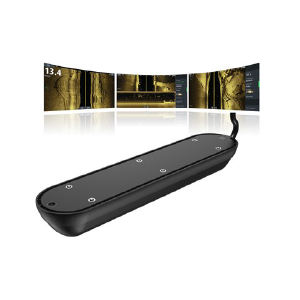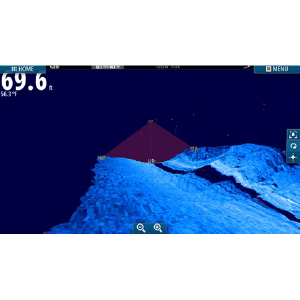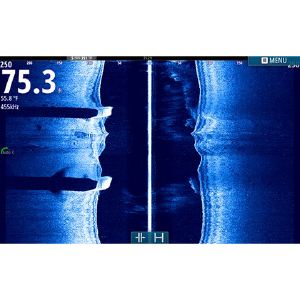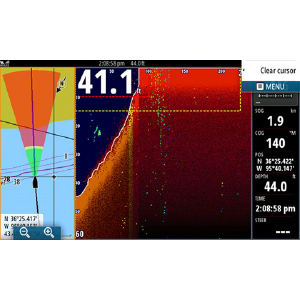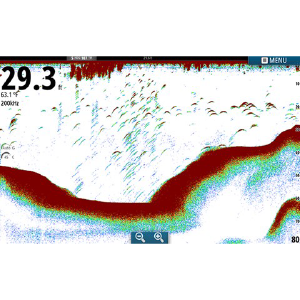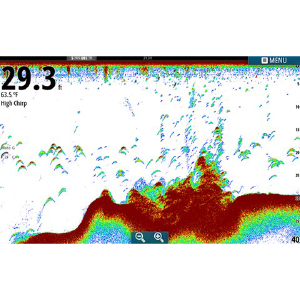|
SIMRAD MARINE ELECTRONICS FOR POWERBOATS & SPORTFISHING
NEW Active Imaging - Sonar and Transducers See structure and cover with a new level of refined detail and at a range unmatched by any other structure imaging technology with Active Imaging™ sonar. The high-level clarity, target separation and detail of Active Imaging will help you find more fish by making it easier to quickly identify fish-holding structure like rockpiles, standing timber, weedbeds, ditches and drop-offs – all at a greater distance from your boat. Get the best of CHIRP sonar and DownScan on one screen with the exclusive FishReveal™ Smart Target view that helps you easily recognize fish from structure and cover on high-detailed DownScan images. Active Imaging is available in 3-in-1 (CHIRP, SideScan and DownScan) and 2-in-1 (SideScan and DownScan) transducers. |
SIMRAD MARINE SONAR AND TRANSDUCERS
Simrad StructureScan 3D ImagingThe latest in Simrad sonar technology, StructureScan 3D imaging scans underwater terrain and fish-holding structure to create a high-resolution, three-dimensional view beneath the water. As well as making it faster than ever to locate structures and changes in bottom layout, 3D imaging makes it possible to examine those features in detail without venturing beneath the water.
The view offered by StructureScan 3D is like a virtual underwater camera and show where features lie in relation to your vessel. You can also choose to pan, tilt and rotate the virtual camera manually in ScanTrack™ control mode, to explore your surroundings from any angle you choose. |
Simrad StructureScan HD ImagingStructureScan HD combines high-frequency DownScan and SideScan sonar imaging technologies to create a picture-like view beneath the water, great for finding submerged structure and changes in bottom layout. By providing a panoramic view out to the side of your boat, StructureScan greatly reduces the time it takes to find fish-holding structure, promising anchorages, and other underwater features of interest.
In addition to StructureScan’s top-down perspective, DownScan overlay combines downward-looking imagery with the output from your CHIRP sonar, painting structure in striking detail while reliably picking out individual fish targets. StructureMap overlays SideScan imagery on your display’s chart page, offering a detailed view of submerged structure as it relates to your position. The specialised StructureScan HD transducer offers selectable 455 kHz operation for maximum imaging range, and 800 kHz for maximum imaging resolution. |
Simrad ForwardScan SonarThis forward-looking sonar provides a clear two-dimensional image of the bottom in front of your vessel, allowing you to navigate shallow or poorly-charted waters with a greater degree of safety.
ForwardScan offers:
The specialised ForwardScan transducer operates at 180 kHz to reduce interference with traditional 200kHz echosounders. It connects to the StructureScan port on Simrad NSS evo2 displays, and on SonarHub™ sounder modules. In order to use both StructureScan and ForwardScan sonar simultaneously, two sonar modules are required; on NSS evo2 systems with built-on sonar, this means just one external sonar module, plus the built-in StructureScan port. |
Simrad Broadband Sonar (50/83/200 kHz)This essential sonar technology is great for tracking depth, finding schools of baitfish, and displaying predator fish in the water column directly beneath your boat. Broadband sonar offers a traditional side-on echosounder view, with ‘fish arches’ formed as fish pass through the downward-facing sonar beam.
Broadband sonar relies on sonar 'pings' and echoes on a single frequency, dictated by your choice of transducer. Most transducers are designed to operate at one of the frequencies below, while 'dual frequency' transducers let you select either of two supported frequencies to best suit your current situation. Available frequencies include:
The more power a single-frequency echosounder can put behind its ping, the stronger the echoes received from the bottom and other submerged targets. That should mean greater depth penetration, and better target detection. However, more power also means more noise in the image – making it harder for you to identify targets on screen. Simrad Broadband sonar uses less power, but varies its ping in a way that actually puts more energy into the water overall. This means greater image quality, with less image noise than conventional single-frequency sounders. |
Simrad CHIRP SonarCHIRP sonar is a powerful bottom-tracking and fish-finding tool. By continuously sweeping through a range of frequencies, CHIRP exceeds many common limitations of single-frequency broadband sonar. While it produces the same side-on echosounder view, CHIRP offers substantially less noise and greater target separation – for example, the ability to discern individual baitfish within a school, or to see multiple closely-spaced game fish that may appear as one target on a broadband sounder.
As with broadband sonar, CHIRP transducers are available in a range of frequencies to suit different depths and applications. Simrad SonarHub™ modules and NSS evo2 displays are also capable of delivering CHIRP functionality using conventional single-frequency transducers, allowing easy and cost-effective retrofit of CHIRP technology into vessels currently wired for broadband sonar.
|


